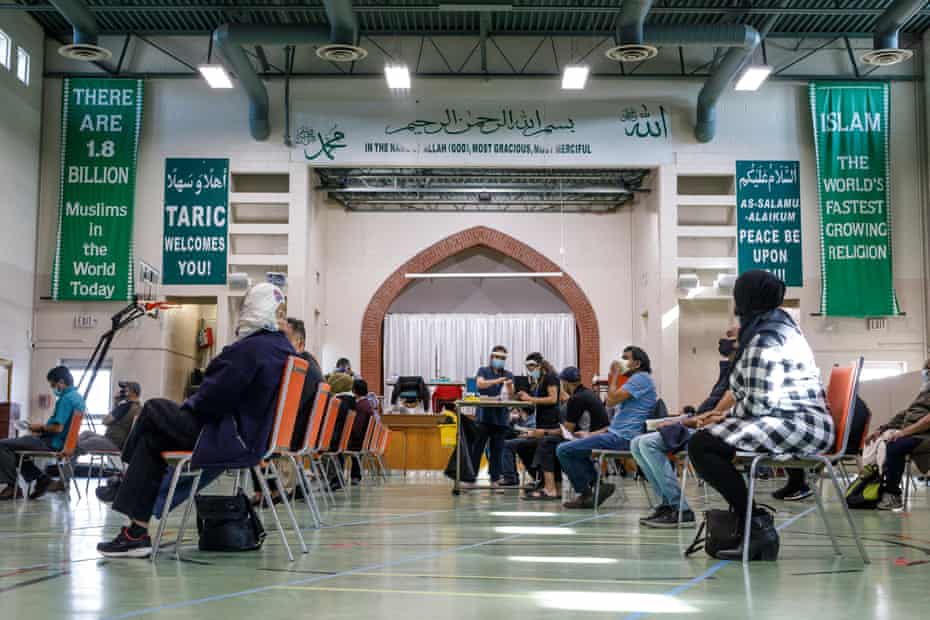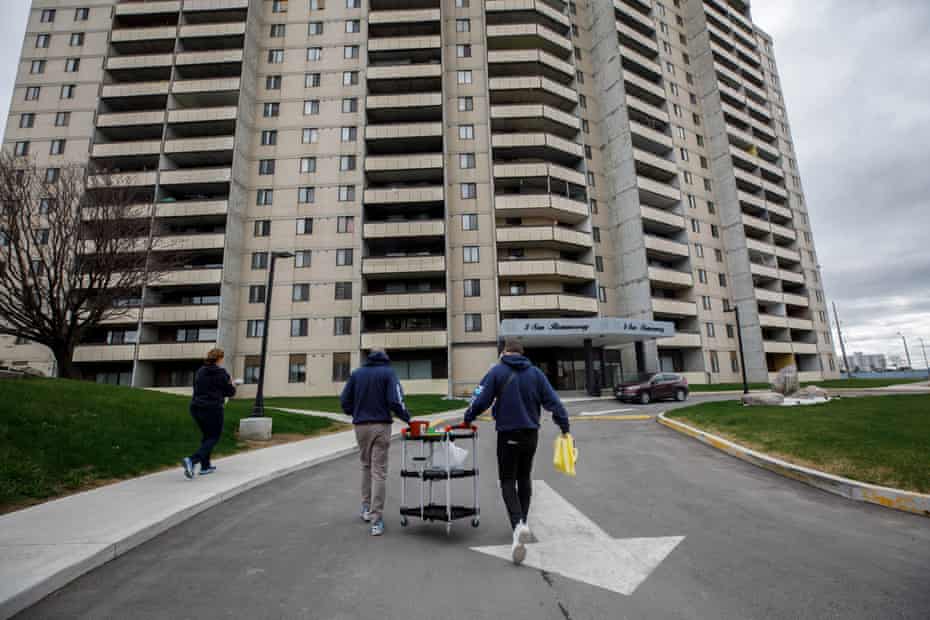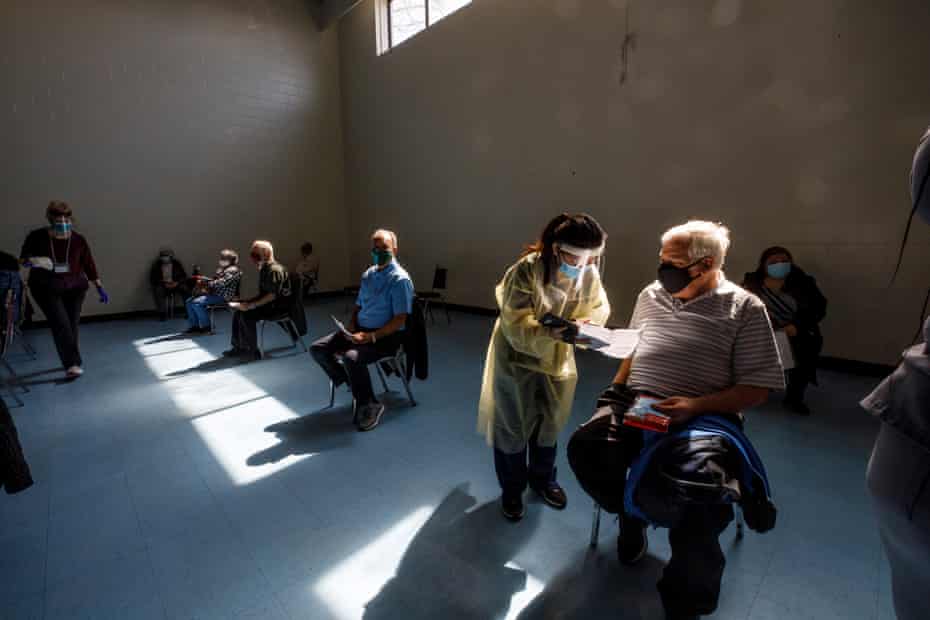On a late April morning, with the third wave of the coronavirus pandemic ripping through Canada’s largest city, nurse Ruben Rodriguez has an ambitious goal: vaccinating nearly 500 people in one of Toronto’s worst-hit neighbourhoods.
Instead of working from one of the city’s mass vaccination sites, however, Rodriguez and a small group of healthcare workers are part of a mobile vaccine team that deploys where they’re needed most.
Clad in billowing surgical gowns and armed with piles of syringes, the team walks the hallways of an apartment complex in Jane and Finch neighbourhood, one of the most ethnically diverse neighbourhoods in the city, but also one of the poorest.
Data from the end of March found only 5.5% of residents of Jane and Finch had been vaccinated, the lowest in Toronto, while nearly one quarter of the city’s wealthiest enclaves had received their doses.
Seated outside their units, residents watch with nervous excitement as the team approaches.
“When you see that relief and the sense of hope the vaccines bring, it fuels you to keep going and do more,” said Rodriguez, who has spent the last month doling out thousands of doses to the city’s highest risk residents.
In recent months, as variants of Covid-19 overwhelm Toronto’s hospitals, areas like Jane and Finch have become the latest battleground in the fight against the virus. Modelling from the province of Ontario predicts the pandemic will worsen in the coming weeks as it affects younger workers – many of whom are precariously employed and live in crowded conditions or intergenerational households.
Officials recognized that Toronto can’t vaccinate its way out of the third wave, but Rodriguez and the team from Humber River hospital are nonetheless working to reach as many people as possible. “Every vaccine we deliver protects against a bad outcome,” he said. “When you get the shot, you’re able to protect your loved ones.”
In previous weeks, with the help of Black Creek community health centre, the team has deployed to churches, mosques and community centres.

In addition to supply shortages and questions over equitable distribution, communities grappling with outbreaks often face numerous barriers to accessing the vaccine.
Without computer literacy and English language skill, booking vaccine appointments can be difficult, say members of the Humber River team.
Because the hospitalization and death rate from the coronavirus is eight times higher in Jane and Finch than wealthy neighbourhoods, community leaders felt the area was a perfect candidate for the mobile delivery team.
The morning begins with the frozen vials of the Moderna vaccine arriving by cooler, its temperature carefully monitored.
“It’s like carrying liquid gold,” said nurse Lisa Bitonti-Bengert, who carried it on her lap in a van from the hospital.

After the small glass bottles defrost, the team fills syringes, carefully extracting every drop, before gathering to plan for the day’s rollout.
They break off into teams and once inside the apartment buildings, begin using the “airplane mode” strategy – pushing a small trolley cart down the hallways, knocking on doors and vaccinating residents. The strategy comes from months of working to vaccinate residents in long-term care homes, the worst hit group of the pandemic’s first and second waves, says Rodriguez, who found the patients appreciated the nimbleness of the group.
“Getting it from our home is so easy. There are no long lineups. We’re so grateful to the community and the doctors,” said Gowsi Prem as she sat beside her husband, moments after receiving their jabs. “Now I feel like I’m safe from Covid. I know [my body] can fight the virus.”
Before a team is deployed, local residents volunteering as “community ambassadors” canvass the building, meeting with tenants to address any concerns and answer questions.
“It’s amazing to see the work everyone is doing to help us get the vaccine,” said Sheila Murphy, an ambassador who helped put up flyers ahead of the event and has been overwhelmed by the interest from tenants. Another ambassador, Adina James, calls the work “an honour and a privilege”.
As the Humber River team move from floor to floor of the towering San Romanoway apartment complex, resident Janelle Brady says it’s “about time” that essential workers and those living in congregant settings could get the vaccine – a feat impossible without leadership from the community.
“It’s really a great show of when the community pulls together to get things done. And I’m not surprised because I’ve grown up and lived in this area. And I’ve seen it time and time again, where community workers and frontline workers come together to support local folks like myself,” said Brady as she waited for her vaccine. “I’m very proud of the job that they have done, but I’m not surprised. It’s just the way we do things around here.”

Many in line have experienced the virus disrupting the lives of family and friends. Rashid Katsina said a friend recently contracted Covid and was so fatigued “he couldn’t even take a shower for almost a week”.
The moment Katsina heard about the opportunity for a vaccine, he rushed over. “I’m thrilled to be getting it. I’m so excited. I can’t even explain how happy I am.”
For others, the day represented the possibility that the city might be moving forward into a new stage of the pandemic.
“It’s finally a chance to feel sort of normal again, that we’re moving forward.” said Lesley, a resident who had volunteered to help with the pop-up clinic–and to get her vaccine. “For me, really, it’s just that little bit of hope that we all need right now.”
This content first appear on the guardian
